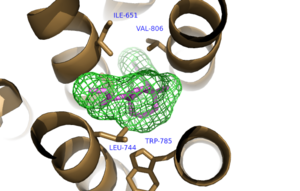metabotropic Glutamate Receptor 5 Homo sapiens
Introduction
G-coupled protein receptors GPCR are trans-membrane proteins that are integral to cell signaling. The human genome encodes for approximately 750 GPCRS, 350 of which are known to respond to extracellular ligands.[1]. GPCRs are divided into four major classes based on sequence similarity and transduction mechanism; Class A,B,C, and F.[2]. Metabotropic Glutamate Receptor 5 (mGlu5) is a class C GPCR that is involved in the Gq pathway [3]. mGlu5is highly expressed in neuronal and glial cells in the central nervous system, where glutamate serves as the major neurotransmitter. When glutamate binds to the extracellular domain of mGlu5, consisting of the Venus Fly Trap [4], a conformational change through the tram-membrane domains activates the coupled G-protein. This G-protein disassociates and the alpha subunit activates Phospholipase C which has the final outcome of increased neuronal activity[2].
|
Introduction
Biological Background
G protein-coupled receptors (GPCRs) can be broken up into four classes: A, B, C, and F. [5]. Metabotropic glutamate receptor 5 (mGLu5) is a Class C GPCR that couples with the Gq pathway [6].
Importance
Function
Structure
 Hydrophobic Pocket Surrounding Mavoglurant  Further Hydrogen Bonding between protein and Mavoglurant Domain highlights
Disease
Relevance
Structural highlights
|


